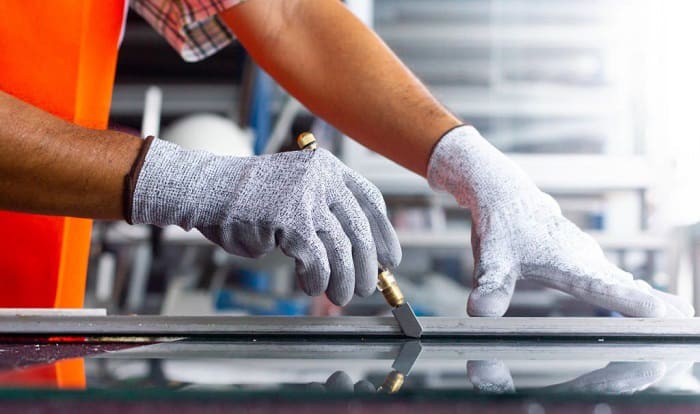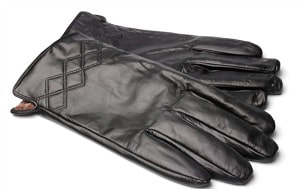There are too many types of gloves in the market, developed and customized for specific purposes, including personal and industrial uses. Indeed, the materials used in constructing the gloves are the determining factors of the glove features and functions.
Therefore, the first questions we ask when purchasing a pair for our tasks or activities should be “What are gloves made of and will such materials meet our requirements?”
For a quick look into the market, the most common glove materials are rubber (including latex, nitrile), vinyl, and leather (including cowdie, goatskin, etc).
Table of Contents
What Materials Are Often Used to Make Gloves?
1. Nitrile Butadiene Rubber
You should be familiar with nitrile as it is a common glove material. It is a synthetic rubber copolymer. Nitrile gloves composition includes butadiene and acrylonitrile, containing no natural rubber latex. Therefore, nitrile gloves are safe for people with allergies to latex.
Furthermore, they are widely used for their malleability, thin structure, and tactile sensitivity, thus excellent for intricate tasks.
This glove material can resist oils, solvents, and greases well while having good protection against some types of bases and acids. Nitrile can also resist punctures, shielding workers from small and pointy objects.
Therefore, these synthetic rubber gloves are important personal protective equipment (PPE) for healthcare settings, food service, automotive work, laboratories, etc.
However, nitrile is not always the best choice for surgeries, as the most expensive, elastic, sensitive, and strong surgical gloves are made of Polyisoprene.
2. Latex (or natural rubber)
Different from nitrile, which is made from synthetic rubber, latex is a natural material. It comes from the harvested latex from the “rubber tree” (or Hevea Brasiliensis).
The best attributes of latex should be its excellent elasticity and resistance to puncture and tear. That’s why powder-free latex gloves are often utilized in food service and medical examinations.
However, medical gloves made of latex should never be used for patients or workers with an allergy to the material.
In addition, latex pairs are known for their protection against inorganic compounds. Therefore, they are ideal gloves to wear for handling various cleaning products.
3. Polyvinyl Chloride (PVC)
PVC and plasticizers are used to make vinyl gloves, another type of synthetic rubber gloves. Indeed, these products are latex-free, thus usable for people with latex allergies.
Vinyl gloves can handle exposure to dyes, detergents, and multiple non-hazardous substances. Furthermore, they are among the affordable choices for protective gloves, ideal for use in handling food, beauty products, cleaning products, and more.
However, it is essential to know that vinyl is not biodegradable, taking even up to a century to partly degrade. Therefore, users should consider if they should use these gloves as they can cause a negative impact on the environment.
4. Leather
Work gloves are often made of leather due to their incredible resistance to heat, chemicals, abrasion, and multiple hazards.
- Cowhide is among the most widely-used and affordable leather materials. Its best properties include durability, dexterity, abrasion and heat resistance. Therefore, cowhide gloves are perfect for winter use.
- We can encounter multiple cowhide work gloves made for automotive, construction, and packaging tasks.
- Goatskin is the next standard leather fabric that boasts excellent softness and flexibility. Goatskin gloves are better for use in wet conditions than cowhide since they do not become stiff after exposure to excessive moisture.
- Furthermore, this type of leather is breathable, allowing good dexterity for detailed tasks. However, it is not the best for keeping warm.
- Pigskin makes a comfortable and water-resistant pair of gloves. The gloves’ breathability and flexibility allow workers to handle tasks with a high level of freedom.
- Still, the best attribute of pigskin leather must be its durability. Workers handling heavy-duty tasks that involve risks of being punctured and cut should make good use of pigskin leather gloves.
- Deerskin is similar to goatskin in its soft and supple properties, constructing the most comfortable leather gloves.
- Notably, deerskin gloves have exceptional protection against heat, thus ideal for welding jobs.
- However, it is not as durable and puncture-resistant as other types of leather materials.
5. Besides common gloves materials mentioned above, you might also encounter other types as follows:
- Neoprene rubber material features reliable protection for tasks involving oils, several kinds of acids, fats, etc.
- Polyurethane (PU) or synthetic leather is generally water-resistant and sturdy without being thick.
- Wool, with its soft and warm attributes, are often made for casual use, fashion purposes, or simply for keeping warmth.
- Butyl Rubber with strongest protection properties against abrasive chemicals
- Polyvinyl Alcohol (PVA) with good resistance against solvents (chlorinated and aromatic)
Conclusion
Now, you already know the most common materials which answer the question “What are gloves made of?” and give an overview of what’s available in the market. Indeed, there is more to these glove materials and glove constructions that might enhance or downplay some of their features.
With that, if you plan to purchase a good pair, checking out the fabric is not enough. Make sure you pay attention to the glove certifications if it’s used for health, food service, or industrial tasks. Also, essential features include linings, cuffs, coatings, foams, and so on.

This is Edward Manning, the editor in chief of Construction Informer. Quite a bit of my time is spent researching the market and interviewing experts in the field so that I can give you reliable information.








